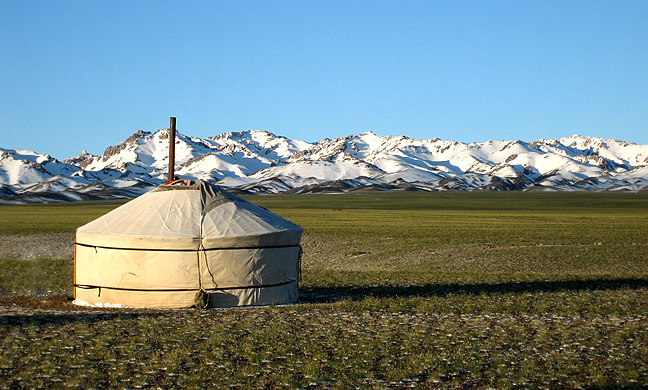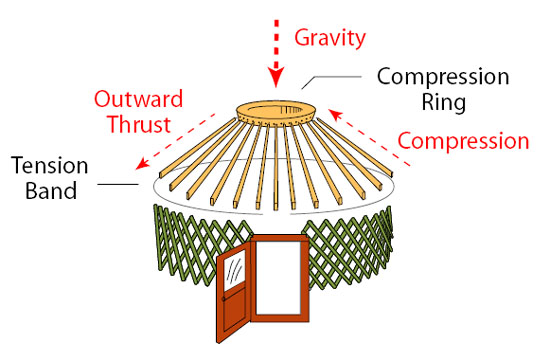Earthquake-proof
They're toasty warm in winter and can be extra waterproofed for protection against heavy rains. Some other really nice features about Mongolian ger domiciles:
Because of this combination of the central compression ring at the top of the roof and the encircling tension band where the roof meets the wall, long roof spans are possible without any internal support system (like posts, trusses or beams). This gives the yurt an uncommon feeling of spaciousness and uplift.
The roof design also creates an incredibly strong and resilient structure that is uniquely equipped to withstand earthquakes, strong winds and heavy snow loads.
Illustration and quote from the FAQ page at yurtinfo.org
Note the part about withstanding earthquakes.
Note too that even if the ger should fall down for some strange reason there will be no wooden posts and beams to come crashing down on the inhabitants' heads. Or their possessions.
Note too there would be no rubble to bury the inhabitants or crush them to death.
Also note that while will some things would break inside the ger during an earthquake they are broken not crushed to bits, so they can be mended.
Bonus to living in gers in an earthquake zone:
If the ger is near edifices that collapsed or were badly damaged in an earthquake, like a bridge or stone walls, the family can just sort of pick up their ger and move it a safe distance away.
Gers are meant to be portable; I don't know how many actual nomads are left in Mongolia but in the old days, at least once a year the gers were packed up and put on ponies or yaks and hauled to other pastures.
Come to think of it, there are still Tibetan nomads -- not many, but don't they also live in gers, or something like them?
Anyhow, gers or yurts are popular these days in many parts of the Western world --
Yurt housing for migrant workers in Napa Valley, California
So they can get very fancy with a price to match. Nepalis who want to build a plain old-fashioned ger should just talk to some Mongols who are knowledgeable on the subject. They'll show how to build it right -- without charging 400 bucks a day for a workshop that one American yurt-building consultant commands -- and on the cheap.
Just a thought, and hoping the advice is taken in the spirit it's given. However if readers in Nepal are like Americans who insist on building Cape Cod cottages on the beach in the Carolinas, I'd be wasting my breath. These Americans will look at you and say, 'It's our tradition' when you point out it's folly to build that kind of domicile in hurricane alley.
If Nepalis say it's their tradition to build houses with stone and wood -- well, why live this way in earthquake alley in the rural areas when there's a much better alternative?
"Wood and stone buildings crumbled easily in the earthquake, collapsing and blanketing the village ..."




No comments:
Post a Comment